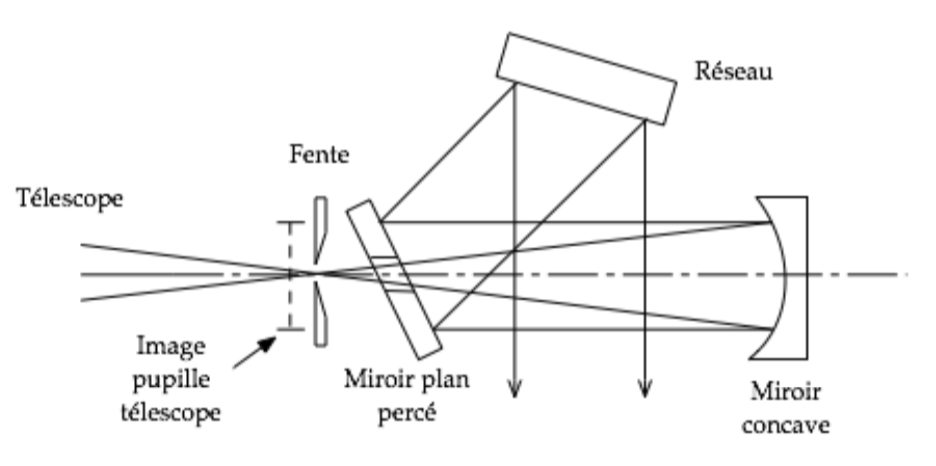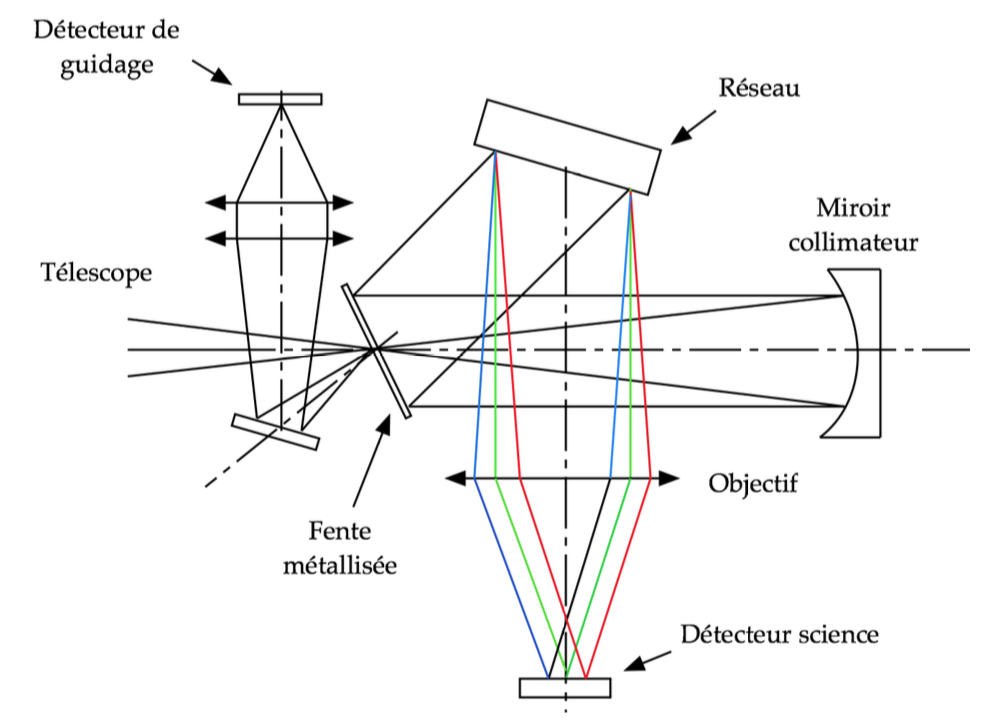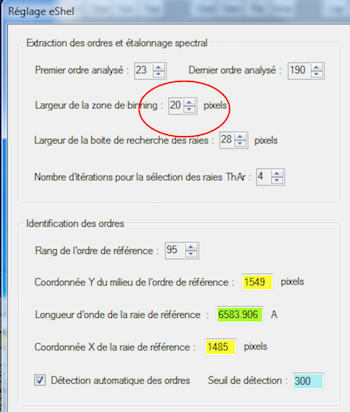First starlight for my new echelle
-
Tim Lester
- Posts: 168
- Joined: Fri Apr 04, 2014 6:31 pm
- Location: Arnprior Ontario
First starlight for my new echelle
I have just acquired my first "real" spectrum with my new home built echelle spectrograph.
The conditions were not good. Clouds interfered with all the integrations but I am very pleased regardless.
The instrument is not fiber coupled but is rigidly built and I will be making a tightly fitted foam enclosure so that I can control its temperature.
So far indications are that flexure will not be a problem (but it is early days). Here is a picture of it mounted on the telescope.
I can cover the spectral range from 4050 to 7750 in one shot and may be able to squeak out even more (the camera lens is the limitation).
Here is a graph of resolution versus wavelength.
And here are my first real results for CH Cyg.
Tim
The conditions were not good. Clouds interfered with all the integrations but I am very pleased regardless.
The instrument is not fiber coupled but is rigidly built and I will be making a tightly fitted foam enclosure so that I can control its temperature.
So far indications are that flexure will not be a problem (but it is early days). Here is a picture of it mounted on the telescope.
I can cover the spectral range from 4050 to 7750 in one shot and may be able to squeak out even more (the camera lens is the limitation).
Here is a graph of resolution versus wavelength.
And here are my first real results for CH Cyg.
Tim
-
Andrew Smith
- Posts: 321
- Joined: Fri Sep 30, 2011 12:23 pm
Re: First starlight for my new echelle
Very impressive Tim. Could you post some information on the design?
Regards Andrew
Regards Andrew
-
Francois Teyssier
- Posts: 1553
- Joined: Fri Sep 23, 2011 1:01 pm
- Location: Rouen
- Contact:
Re: First starlight for my new echelle
Yes, impressive!
Good resolution, good SNR
Congratulations, Tim
François
Good resolution, good SNR
Congratulations, Tim
François
François Teyssier
http://www.astronomie-amateur.fr
http://www.astronomie-amateur.fr
-
Joan Guarro Flo
- Posts: 685
- Joined: Thu Nov 03, 2011 8:50 pm
Re: First starlight for my new echelle
Congratulations Tim !!
Your spectrograf echelle gives a good result. We hope to see good observations soon.
Regards, Joan.
Your spectrograf echelle gives a good result. We hope to see good observations soon.
Regards, Joan.
-
Tim Lester
- Posts: 168
- Joined: Fri Apr 04, 2014 6:31 pm
- Location: Arnprior Ontario
Re: First starlight for my new echelle
Thanks everyone. I guess you can tell that I am pretty pleased with how well it works. now all I need is some clear weather!
Here are a few details about the design.
The telescope is a 310mm DK cassegrain at f9.8 and the spectrograph has a built in f6.6 reducer.
The slit is reflective with a 23um x 75um aperture. The 75 um width still gives enough separation between orders all the way out to 8000 A but it turns out to be borderline for ISIS processing. I will explain further in another post.
The collimator is a 100mm focal length spherical mirror. this places an image of the telescope entrance pupil very near a perforated folding mirror. The cassegrain secondary blocks the center of the entrance pupil any way so no light is lost due to the perforation. For a mirror of this size The spherical aberration is smaller than the diffraction limit. A mirror collimator has the advantage of not producing any additional chromatic aberration.
The grating is a Thor labs echelle with 63 degree blaze, 79 lpmm. The blaze angle actually turned out to be 61.5 degrees. It is twisted to a gamma angle of 7 degrees (14 degrees between incident and reflected) so the spectral lines are slanted at about 22 degrees.
The cross disperser is an F2 prism and the camera is an 85mm f1.8 Nikon lens.
The detector can by tilted in the cross dispersion direction to try and maintain focus at the blue end.
Here is a drawing of the internals. The slit housing is rotated 90 degrees from its true orientation in this view.
I haven't taken a picture of the inside yet but don't want to open it up just at the moment.
Tim
Here are a few details about the design.
The telescope is a 310mm DK cassegrain at f9.8 and the spectrograph has a built in f6.6 reducer.
The slit is reflective with a 23um x 75um aperture. The 75 um width still gives enough separation between orders all the way out to 8000 A but it turns out to be borderline for ISIS processing. I will explain further in another post.
The collimator is a 100mm focal length spherical mirror. this places an image of the telescope entrance pupil very near a perforated folding mirror. The cassegrain secondary blocks the center of the entrance pupil any way so no light is lost due to the perforation. For a mirror of this size The spherical aberration is smaller than the diffraction limit. A mirror collimator has the advantage of not producing any additional chromatic aberration.
The grating is a Thor labs echelle with 63 degree blaze, 79 lpmm. The blaze angle actually turned out to be 61.5 degrees. It is twisted to a gamma angle of 7 degrees (14 degrees between incident and reflected) so the spectral lines are slanted at about 22 degrees.
The cross disperser is an F2 prism and the camera is an 85mm f1.8 Nikon lens.
The detector can by tilted in the cross dispersion direction to try and maintain focus at the blue end.
Here is a drawing of the internals. The slit housing is rotated 90 degrees from its true orientation in this view.
I haven't taken a picture of the inside yet but don't want to open it up just at the moment.
Tim
-
Andrew Smith
- Posts: 321
- Joined: Fri Sep 30, 2011 12:23 pm
Re: First starlight for my new echelle
A stunning design Tim. The design and workmanship looks to be of a professional standard and could be the basis of a commercial product.
Do you have any problems with the processing with the star being located in slightly different positions on the slit?
Where did you get the perforated flat from?
Regards Andrew
Do you have any problems with the processing with the star being located in slightly different positions on the slit?
Where did you get the perforated flat from?
Regards Andrew
-
Christian Buil
- Posts: 1432
- Joined: Mon Sep 26, 2011 6:59 pm
- Contact:
Re: First starlight for my new echelle
Perforated mirror is the great solution for design compact spectrograph, here for exemple one of my numerous project...

A tip is to use a metalized slit, like Shelyak slit (two simultaneaous functions - guiding and folding):

...but chromium coating reflectance is not excellent (aluminium slit is really better...).
Tim, can you explain more about your hole mirror ?
Christian

A tip is to use a metalized slit, like Shelyak slit (two simultaneaous functions - guiding and folding):

...but chromium coating reflectance is not excellent (aluminium slit is really better...).
Tim, can you explain more about your hole mirror ?
Christian
-
Tim Lester
- Posts: 168
- Joined: Fri Apr 04, 2014 6:31 pm
- Location: Arnprior Ontario
Re: First starlight for my new echelle
The flat is a Thorlabs dielectric coated mirror that is 6 mm thick. I bored the 5/32 inch hole myself with a diamond drill. This is quite easy to do.
Simply mount the mirror face down on another small piece of glass with optical pitch and bore the hole from the back side while immersed in water.
After drilling carefully clean off ALL the drilling debris and then heat up the assembly and carefully float the mirror to the edge of the glass plate and off, then clean up with acetone.
Dielectric coatings (or protected aluminum coatings) are rugged enough to survive this treatmentt undamaged.
The star image is guided quite accurately in the middle of the slit which produces a Gaussian profile centred on the 75um width. Isis handles this just fine.
However it is another story for the tungsten flats.
Here is the profile for my flat in order 32. Notice the increased noise near the peak of the blaze, right where you would expect less noise! If I generate a profile in MaximDL from the straightened image of the flat for order 32 it is smooth, as it should be. However, If I narrow the zone over which MaximDL averages then the profile starts to look like it does in ISIS. I believe this shows that Isis is not quite capturing the whole 75um line width. This makes sense as ISIS was designed with a 50um fiber in mind.
This problem does not impact the star spectra directly because the gausian star profile has fallen off significantly towards the ends of the short slit.
It does, however, affect the accuracy of the blaze function that is generated from the tungsten flats.
Christian - if you are reading this I would be very grateful if you could add to ISIS an option to specify a slightly wider zone over which to integrate.


The reflective aperture was the hardest part for me to source. I had to wait over a year for it. It was made as a favour by the Nanofabrication Lab at our national research facility.
I can NOT ask for them to make another one with a shorter aperture.
Tim
Simply mount the mirror face down on another small piece of glass with optical pitch and bore the hole from the back side while immersed in water.
After drilling carefully clean off ALL the drilling debris and then heat up the assembly and carefully float the mirror to the edge of the glass plate and off, then clean up with acetone.
Dielectric coatings (or protected aluminum coatings) are rugged enough to survive this treatmentt undamaged.
The star image is guided quite accurately in the middle of the slit which produces a Gaussian profile centred on the 75um width. Isis handles this just fine.
However it is another story for the tungsten flats.
Here is the profile for my flat in order 32. Notice the increased noise near the peak of the blaze, right where you would expect less noise! If I generate a profile in MaximDL from the straightened image of the flat for order 32 it is smooth, as it should be. However, If I narrow the zone over which MaximDL averages then the profile starts to look like it does in ISIS. I believe this shows that Isis is not quite capturing the whole 75um line width. This makes sense as ISIS was designed with a 50um fiber in mind.
This problem does not impact the star spectra directly because the gausian star profile has fallen off significantly towards the ends of the short slit.
It does, however, affect the accuracy of the blaze function that is generated from the tungsten flats.
Christian - if you are reading this I would be very grateful if you could add to ISIS an option to specify a slightly wider zone over which to integrate.
The reflective aperture was the hardest part for me to source. I had to wait over a year for it. It was made as a favour by the Nanofabrication Lab at our national research facility.
I can NOT ask for them to make another one with a shorter aperture.
Tim
-
Christian Buil
- Posts: 1432
- Joined: Mon Sep 26, 2011 6:59 pm
- Contact:
Re: First starlight for my new echelle
Hi Tim,
Thanks for the answer.
About flat ripple, did you try to adjust the binning width adjustment option ?

Christian
Thanks for the answer.
About flat ripple, did you try to adjust the binning width adjustment option ?

Christian
-
Tim Lester
- Posts: 168
- Joined: Fri Apr 04, 2014 6:31 pm
- Location: Arnprior Ontario
Re: First starlight for my new echelle
Thanks for your quick reply Christian.
I had not fully appreciated what the binning width was but I had set it to 12 which should be a good value in my case.
Looking at the flat images the smallest binning width that would capture everything is about 8 and 20 would start to include the orders on either side (for order 32).
I have tried all values from 8 to 20 and nothing changes. Interestingly order 29 is smooth as are all the orders above 35. The flat plots for the problem orders 30 - 35 do not change at all with binning width. The matching MaximDL profiles generated from the flat images are all smooth.
I tried using an artificial perfectly uniform PRNU file in case a bad PRNU was the problem but that wasn't it.
What next? This is a little troubling. I have uploaded my working directory here if you would like to take a look: https://1drv.ms/f/s!AvXqhKI5kEGRkQbnMJRnLH8EYZyz
Tim
I had not fully appreciated what the binning width was but I had set it to 12 which should be a good value in my case.
Looking at the flat images the smallest binning width that would capture everything is about 8 and 20 would start to include the orders on either side (for order 32).
I have tried all values from 8 to 20 and nothing changes. Interestingly order 29 is smooth as are all the orders above 35. The flat plots for the problem orders 30 - 35 do not change at all with binning width. The matching MaximDL profiles generated from the flat images are all smooth.
I tried using an artificial perfectly uniform PRNU file in case a bad PRNU was the problem but that wasn't it.
What next? This is a little troubling. I have uploaded my working directory here if you would like to take a look: https://1drv.ms/f/s!AvXqhKI5kEGRkQbnMJRnLH8EYZyz
Tim